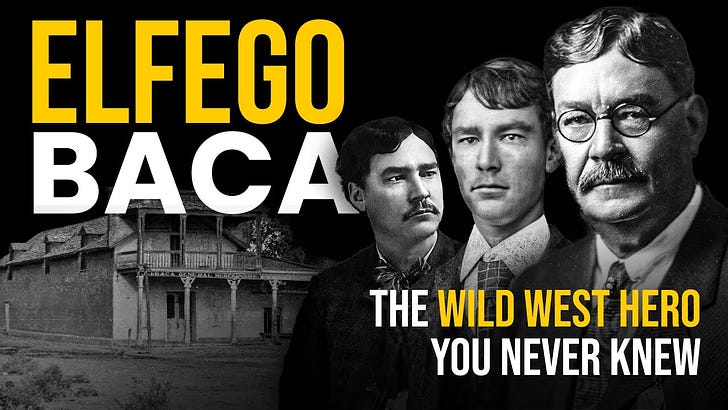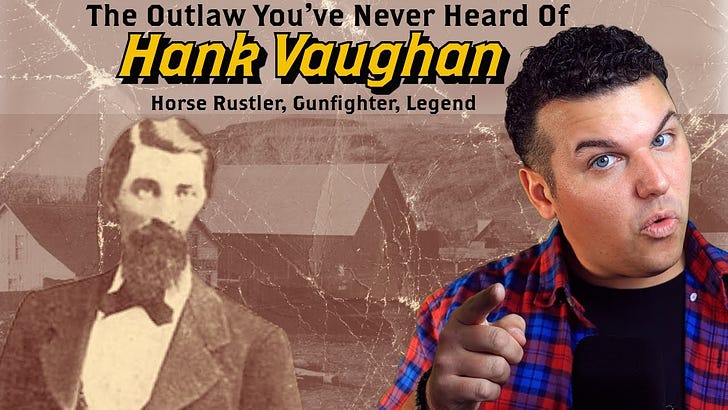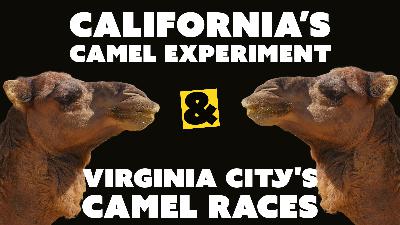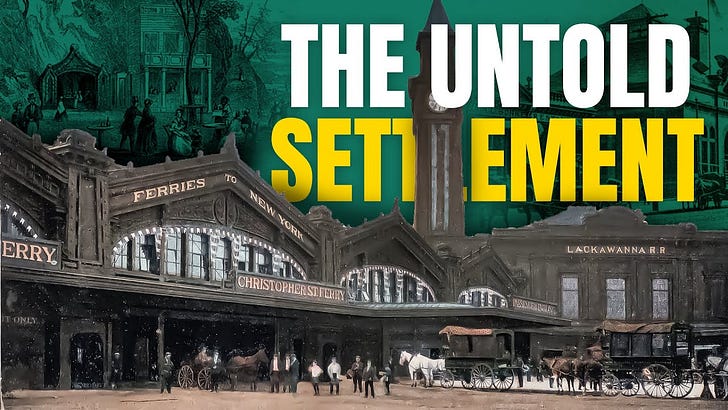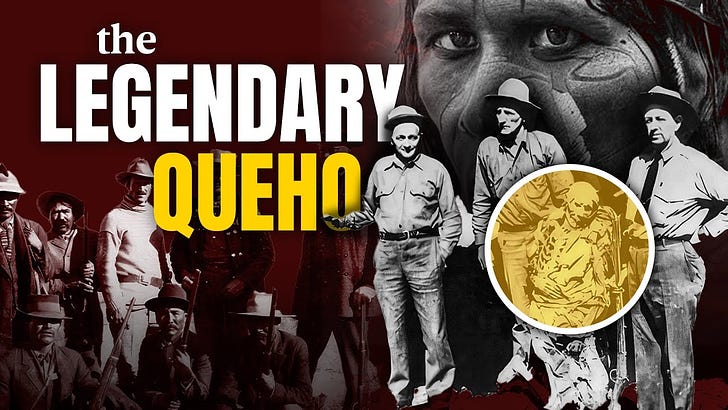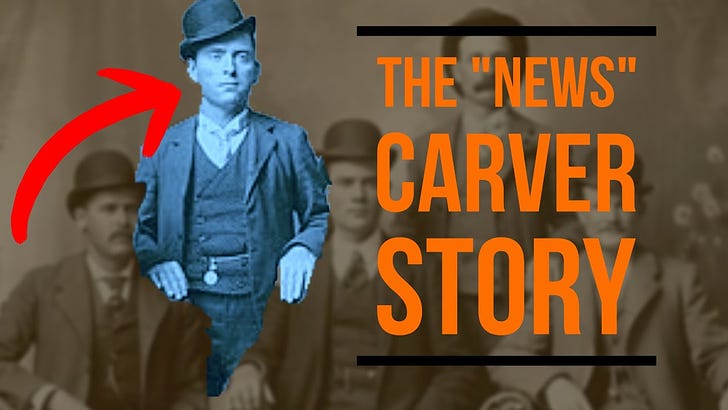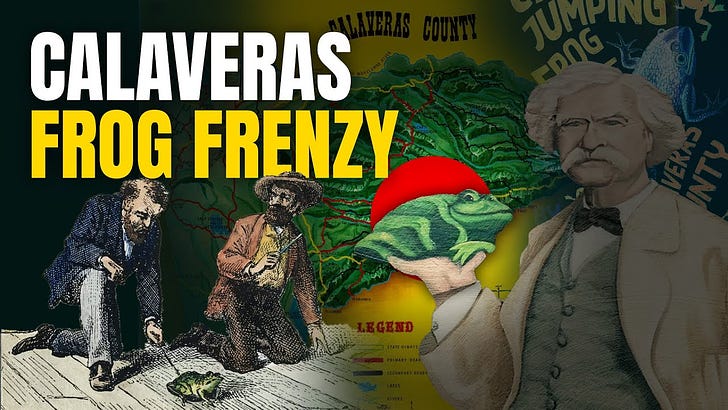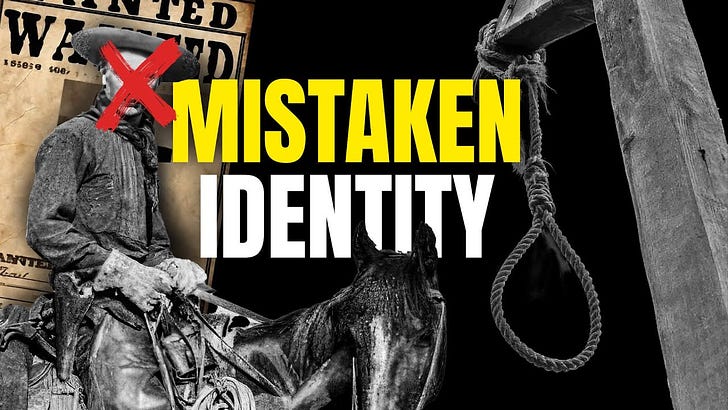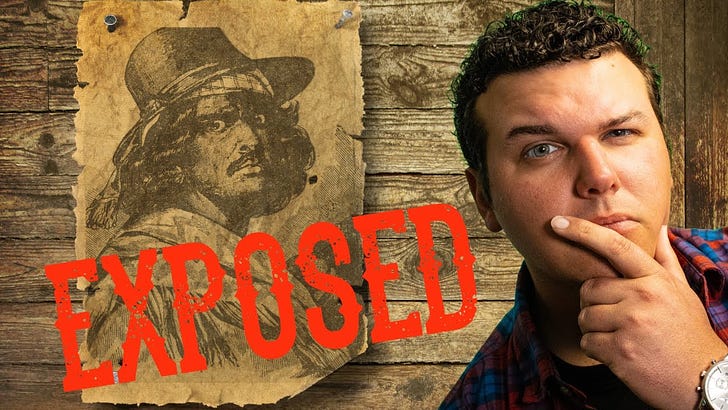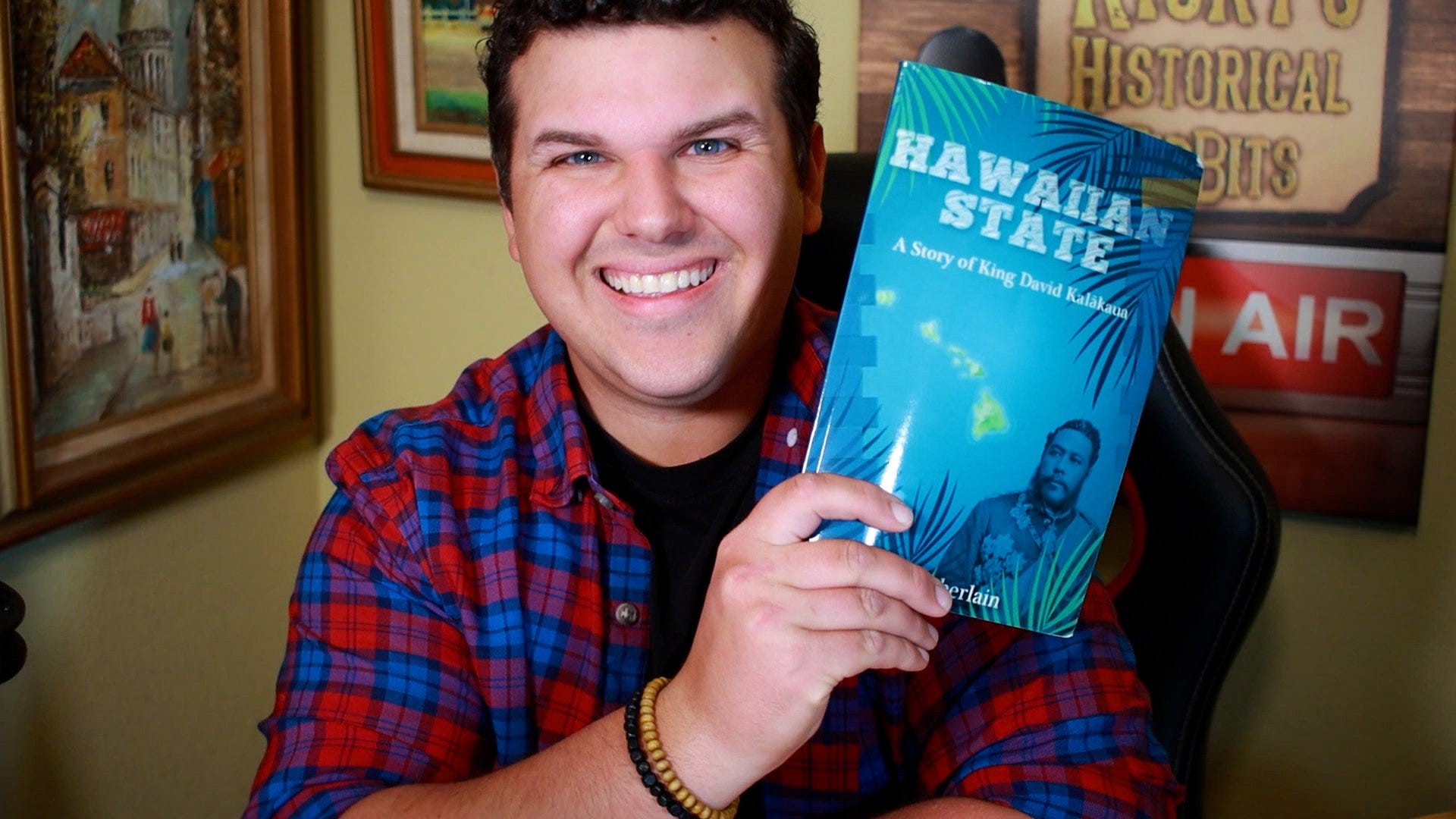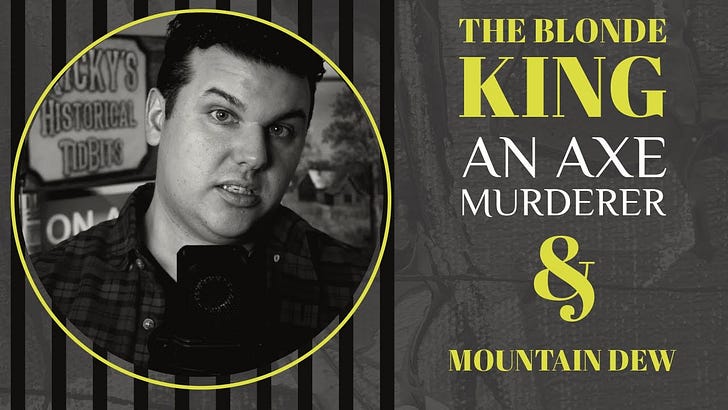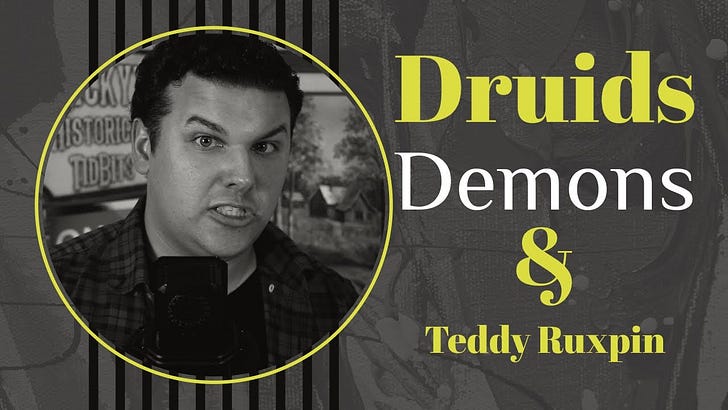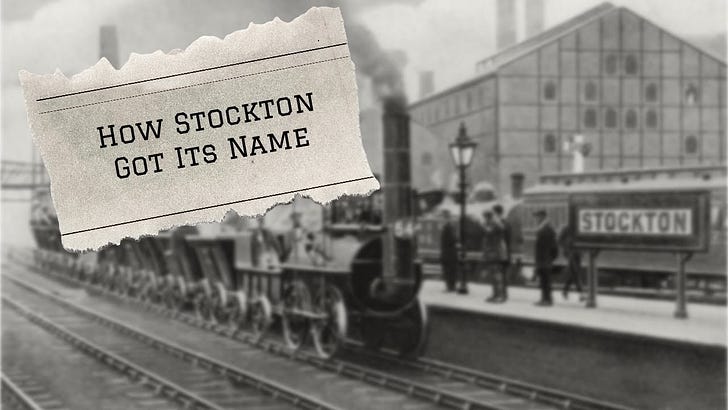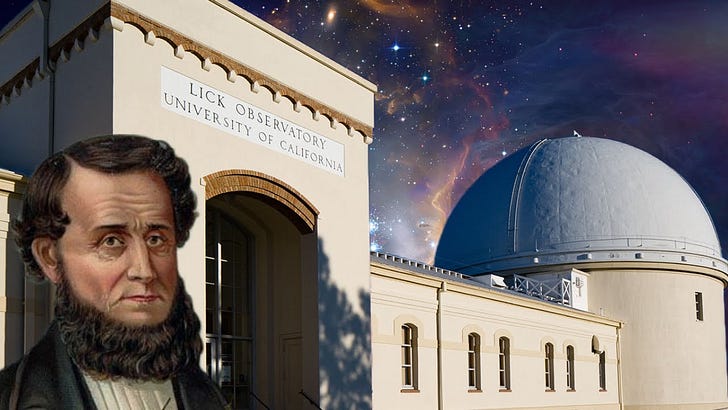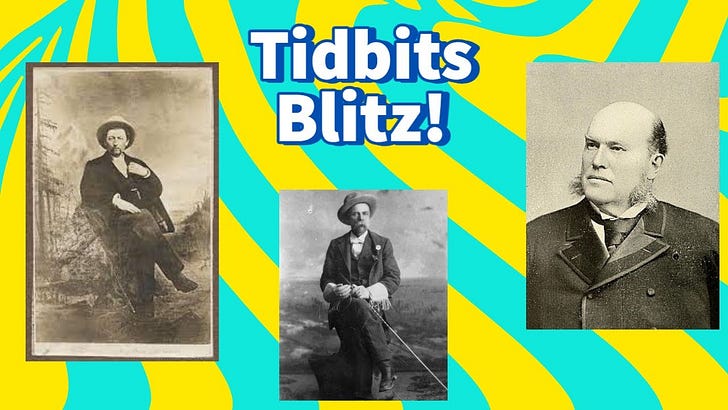Discover Ricky's Historical Tidbits Podcast
Ricky's Historical Tidbits Podcast

Ricky's Historical Tidbits Podcast
Author: Ricky Mortensen
Subscribed: 2Played: 10Subscribe
Share
© Ricky Mortensen
Description
NorCal History show that does not bog you down with dates and names and focus' on stories. Hosted by Ricky Mortensen
rickymortensen.substack.com
rickymortensen.substack.com
40 Episodes
Reverse
In this episode of Ricky’s Historical Tidbits Podcast, dive deep into the shocking history of bull and bear fights in 1850s California—how they started, where they happened, and why they eventually disappeared. Through vivid storytelling, follow an eight-year-old boy witnessing his first fight, feel the tension of the crowd, and experience the brutality of the final showdown. Then of course I'll share some fun facts and an interesting Historical Tidbit! Prefer to read? https://www.rickyshistoricaltidbits.com/articles/the-sport-too-brutal-for-the-wild-west This is a public episode. If you would like to discuss this with other subscribers or get access to bonus episodes, visit rickymortensen.substack.com
You’ve heard of Billy the Kid and Jesse James, but have you ever heard of Elfego Baca? This guy didn’t just survive one of the most insane shootouts in Wild West history—he went on to become a sheriff, a lawyer, and somehow got mixed up with Pancho Villa during the Mexican Revolution. From taking on Texas cowboys to representing revolutionaries and stealing Villa’s prized rifle, Elfego lived a life packed with grit, guts, and plenty of near-death moments. In this episode, we dive into the Frisco War, where Elfego faced down 80 men and survived over 4,000 bullets, the wild jailbreaks, and Elfego’s epic scheme to collect a bounty on his own head. This story has everything—gunfights, revolutions, politics, and even a courtroom drama. So, grab a drink and listen in as we uncover the wild and lesser-known tale of Elfego Baca.Prefer to read? https://www.rickyshistoricaltidbits.com/articles/the-legend-of-elfego-baca-shootouts-law-and-the-mexican-revolution This is a public episode. If you would like to discuss this with other subscribers or get access to bonus episodes, visit rickymortensen.substack.com
Get ready to saddle up for one of the most jaw-dropping outlaw stories from the Wild West that you’ve probably never heard of—Hank Vaughan. He wasn’t just some two-bit criminal. No, this guy was a horse-rustling mastermind, a daredevil gunslinger, and somehow, he managed to cheat death more times than should be humanly possible.In this episode, I take you through Hank’s chaotic life—from his days of selling horses at 12 years old to his life as one of Oregon’s most notorious outlaws. We’ll cover his infamous shootouts, his wild escape off Pilot Rock, and how he turned horse thievery into an art form. If you’ve ever wanted to hear a story about an outlaw who truly lived life on the edge (and then some), you’re in the right place.So, grab a drink, sit back, and enjoy the wild ride that is the story of Hank Vaughan. Trust me, you won’t believe half of what this guy pulled off!🔹 Highlights:* Hank’s early years and how he got into horse thievery* The insane Pilot Rock jump that left a posse speechless* His notorious Missouri Duel, where close range had a whole new meaning* Hank’s final years, filled with bar stunts, practical jokes, and one last tragic ride🎙 Listen Now on Spotify, Apple Podcasts, iHeartRadio, or wherever you get your podcasts!#OutlawLegends #HankVaughan #WildWestPodcast #OregonHistory #WesternStories #GunfightsAndRustlers #OldWestOutlaws This is a public episode. If you would like to discuss this with other subscribers or get access to bonus episodes, visit rickymortensen.substack.com
In this episode of Ricky's Historical Tidbits, we will explore the surprising story behind the California Camel Experiment and its connection to the Virginia City Camel Races. From the mid-19th century trials of camels in the American Southwest to the whimsical camel races in Nevada today, I'll take you on a journey through this quirky slice of history. Learn about the ambitious camel experiment, the camels' unexpected successes and failures, and how these animals ended up racing in Virginia City. Join me for a blend of fascinating history and fun tales that highlight this unusual chapter of America's past!(Video version will go live at 6am on 8/6/2024)Read the blog version This is a public episode. If you would like to discuss this with other subscribers or get access to bonus episodes, visit rickymortensen.substack.com
“Eat drink and be merry for tomorrow we die.”“Carpe Diem”“Gather ye rosebuds while ye may, Old time is still a-flying; And this same flower that smiles today Tomorrow will be dying.”What do all of these sayings have in common?They can describe the city in California nearby Sacramento that boomed for just a month. The people knew it wouldn't last, but at the time Sacramento was uninhabitable so they did the most American thing there is and shook the mud off their boots rose to the occasion and made the most of a bad situation. What city am I talking about?Hoboken, and this is no jokin'Click here to read This is a public episode. If you would like to discuss this with other subscribers or get access to bonus episodes, visit rickymortensen.substack.com
Queho was and is known for being Nevada's first serial killer who was never caught. To read click this link This is a public episode. If you would like to discuss this with other subscribers or get access to bonus episodes, visit rickymortensen.substack.com
Butch Cassidy is a famous outlaw so this episode I share the story of one of his “Wild Bunch” a guy known as News CarverTo read the Article version Click here This is a public episode. If you would like to discuss this with other subscribers or get access to bonus episodes, visit rickymortensen.substack.com
Calaveras County in Northern California Absolutely loves frogs, they are obsessed. Frog murals, frog statues, frog plaques, a frog walk of fame and of course they have the annual Jumping Frog Jubilee where they have the annual Jumping frog competition. So why is Calaveras County, Angels Camp in particular, frog obsessed? To the point there was a court case that went to the Calaveras Supreme Court about a frogs and toads? Well To answer that question You need to watch/Listen/Read this episode. link to read This is a public episode. If you would like to discuss this with other subscribers or get access to bonus episodes, visit rickymortensen.substack.com
Yankee Jim was the victim of mistaken identity, there were two criminals back in the early 1850's known by the name Yankee Jim. Both were tall, both were criminals but one more so than the other. Nowadays most don't know there were two and make the same mistake the court in San Diego made and combine the two men into one. Intrigued? This is a public episode. If you would like to discuss this with other subscribers or get access to bonus episodes, visit rickymortensen.substack.com
Could I have stumbled upon THE John from the Irish folk song John Kanaka? Come along with me and learn the story of a Kanaka who was never supposed to be and his adventures in California.Prefer to read? Click here Sponsor links belowHawaiian State - Book 1Hawaiian Legacy - Book 2Hawaiian Legend - Book 3 This is a public episode. If you would like to discuss this with other subscribers or get access to bonus episodes, visit rickymortensen.substack.com
Get ready to challenge everything you thought you knew about one of California's most notorious outlaws...Joaquin Murrieta, the infamous figure known as the 'Robin Hood of the El Dorado.' Join me and delve deep into the dusty archives of history, to uncover the truth behind Murrieta's notorious exploits and separate fact from fiction. This episode will challenge long-standing myths and unearth the real story behind one of California's most enigmatic outlaws. This is a public episode. If you would like to discuss this with other subscribers or get access to bonus episodes, visit rickymortensen.substack.com
Do you ever think about how animals are relocated? I'm sure you've seen a horse in on of those trailers on the road or put your dog on a plane but I'm talking about wild animals. Like Beavers.Idaho has quite the story about relocating a bunch of beavers after World War Two and I will tell you that story.SponsorHawaiian State - Book 1 Hawaiian Legacy - Book 2Hawaiian Legend - Book 3 This is a public episode. If you would like to discuss this with other subscribers or get access to bonus episodes, visit rickymortensen.substack.com
Living on the west coast in the United States you might think that to see Civil War artifacts, you gotta head on down to the South where it was fought or go to a museum. What if I told you there are some Civil War Cannons in plain sight in Northern California? But before I tell you about that…This is sponsored by The Hawaiian State book series by Joseph Chamberlain. This historical fiction series is an easy read and if you ever had any kind of curiosity on how Hawaii dealt with all the different coups to take it over then you'll love it.Hawaiian State - Book 1Hawaiian Legacy - Book 2Hawaiian Legend - Book 3 This is a public episode. If you would like to discuss this with other subscribers or get access to bonus episodes, visit rickymortensen.substack.com
My professional photographer Grandpa and I went out for a photography trip up at Mount Rainer here in Washington. As a history lover I always have my eyes set out to learn the local history around me and sure enough I came across something pretty interesting. This is a public episode. If you would like to discuss this with other subscribers or get access to bonus episodes, visit rickymortensen.substack.com
In this episode, I will be telling you all about 5 different men, John Sutter, Sam Brannan, Sam Barlow, James Savage, and Doc Maynard. Each of these men made some kind of impact on the western United States.You can listen now but This episode will be premiering in all its glory on YouTube at 7.15pm tonight. on 2/21/24 each of the 5 will be posted as separate videos for you to share.The Blog Versions will be on my website in about a week. This is a public episode. If you would like to discuss this with other subscribers or get access to bonus episodes, visit rickymortensen.substack.com
Listen, Watch or Read. The Choice is yours.Ancient Celtic Druids base their holidays on the wheel of the year.The Celtic year was divided into 2 halves the light and the dark. Within The halves, there would be 4 fire festivals. Samhain was the name of the fire festival that marked the beginning of the dark half of the year.During Samhain, it is said that the world of the gods and goddesses is made visible, and spirits from the otherworld return to earth. To keep these spirits happy the Celts would put offerings and sacrifices outside of the town for their enjoyment.The people would wear skins and costumes of animals to confuse the spirits from knowing who was who in case they had a beef with someone.Bonfires would be made and the shamanic druid priests would give psychic readings to the people.Often during this time monsters and demonic spirits would come by and kidnap and kill people.Phere was Phookah which is a shape-shifting creature typically rabbit-like or horse-like.There was Lady Gyn who was a headless woman who chased people around with her trusty demonic black pig.The Dullahan which you might recognize better as the headless horseman would carry his head and ride a black horse with deep red eyes. If you saw him that was a death omen.Then There was the faery host which was a group of hunter fairy spirits who kidnapped people.Generally, people feared the spirits, and for good reason. But as time went on people became enthralled with spirits, the occult, Gnosticism, Wicca, and so on.In the Middle Ages Dumb supper came about where people would leave all the doors and windows open for the spirits to come in and take part in the feast, children would play games to entertain the spirits and the family would update the invisible visitors on how life wasMumming came out of that, which was caroling door to door on Samhain to entertain the spirits who were participating in dumb supper. In return, cakes would be given to those carolers.Put it all together and you can see where we get our modern secular "holiday" Halloween.I got a great show for you today I'll tell you about the Druids of California, I'll give you the stories of Dyer Lane and its true history, We'll look into the Esoteric Fraternity up in Applegate and check in on the Bohemian Grove near San Francisco and then we'll travel all the way up to Seattle for a mass murder story. Plus some other stuff. Sit back relax and get ready to learn.Every time I have driven around or through Placerville there's a strange pillar in the middle of the street with what looks to be a flame on the top.One day while driving by, I noticed on the plaque that it says Druids of California.I don't know about you but I had never heard of a druid but it sounded kinda weird. I didn't think much about it after that but then I heard a preacher mention druids one day and I remembered that pillar. I still never looked into it, I didn't care all that much. Just a passing curiosity, you know. I bet at least one of you has been curious if you have seen it, and those that haven't are at least slightly intrigued now that I mentioned it.So, I spent a few hours researching all I could for you, and here's the story.The pillar is a memorial to a guy who is the man who successfully brought druidism to the state of California. His name was Frederick Sieg. A German who immigrated to the States and lived in St. Louis where he was introduced to the ideas of druidism.He eventually caught gold fever and moved to California, he slaved away as a miner for a little bit until he settled over in Hangtown "Placerville".In Placerville, he made it his mission to bring The United Ancient Druid Order to fruition in California. Two others had tried, once in Sacramento and once in San Francisco but there wasn't much interest, and Sacramento in particular had a big fire that spread the potential members in all directions.Frederick did well and got a whole, 2 people on board and soon more until there was enough demand that he made 2 more "groves" which is the druid’s name for their meeting place, One in Coloma and another in San Francisco.Now, The pillar monument was installed back in 1926, thirty-eight years after Frederick's death.On the Pillar, there is a druidic emblem which in their words "shows a flaming pyre surmounted by a crossed spear and a long-handled sickle. Oaks, Mistletoe, Daffodil, and the all-seeing eye in the triangle.So that answers what the heck that thing is, but it begs the question...What is a druid?Well, that depends on 10 billion different things. Druidism isn't like other religions where they all believe the same general thing with some differences within denominations based on theology. Druids are like snowflakes, no two are alike,There are even differences in whether it’s a religious druid or a social druid.But generally speaking, Druids are a secret society like the Freemasons. They have very similar rituals and beliefs and can be religious or more social, based on the grouping.The kind that the pillar in Placerville memorializes is more of the social club type. They are like the Rotary Club in a way from what I was able to figure out.But there are very different kinds of druids. Historically they were cannibalistic mass murderers, in fact, The Burning Man over in Nevada kind of takes after a practice the druids would do. Druids would build a massive cage in the form of a man out of wicker and fill it with people to sacrifice and would light them all on fire. They would grab as many criminals as they could but if they needed to throw innocent people in there to fill it up, they would.Modern religious Druidism is essentially New Age and Wiccan most are pantheists meaning they believe their gods and goddesses are in everything. Many believe in reincarnation similar to the Hindu but in particular they believe souls are not unique and that once a person dies they are reborn in the other world and then when they die in the other world they are born in this world. whether that be as a human or some kind of animal.For example, they have records of a guy named Tuan Mac Coriall who they say lived 100 years a man, 300 a deer, 300 a boar, 300 a bird, and 300 a salmon... but other records show he lived 100 years a man, 20 a hog, 30 a stag, 100 an eagle and 30 a fish.Simply put, Druidism in terms of ancient times was a pagan religion, very shamanic and secretive, it takes about 12 to 15 years to become a druid and they have hardly any verifiable history. Druids were written about in literature in medieval times both in a positive light and a negative light.historically, Julius Caesar is quoted as saying that the druids were in charge of public and private sacrifices they refused to pay taxes and were pacifists.The Druids say they built the Stonehenge but there's no telling if that's true or not.But let's go back to that pillar.These druids from what I could tell, have nothing to do with the religious type.1781 in London a social club for men formed and was called The Ancient Druidic Order. They operated secretly as the other clubs of those days did. As time went on, The organization split in two creating The United Ancient Druidic Order in 1833. This offshoot then made its way to Boston and then to St. Louis where Frederick Sieg became a member.The religious Druids claim Merlin as one of theirs. as you could figure.The social club kind of druid from England has its own celebrity, Sir Winston Churchill.Now you know what that pillar is, who it memorializes, The History and distinction of which kind of Druids. But one thing I should point out is that just because there is a distinction doesn't mean a person can't be a member of both. Late at night, it is said you can find druids gathering at the pillar.Some of you guys send me things to check out, read, and add to my enormous list of people and topics to cover in future podcasts. I do this show on my downtime which there isn't much of which is why I don't post episodes often or keep a schedule. Well, Back when I was doing the episode on E. Clampus Vitus I was messaged about a group called The Esoteric Fraternity, I added it to my list and chose it for one of the stories for this episode.So... What the heck is The Esoteric Fraternity?Some would say it was and is some kind of new-age Christian science sex cult. Members of course would argue so let’s dive on in.There was once a man named Hiram Erastus Butler. He was in the Union army during the Civil War building roads and bridges not for the cause of the North. He was stationed at a hospital where he met a gal and they got married. As soon as she bore him two children he went to get some milk at the store and must have forgotten that he had 2 kids and a wife because they never saw him again.He worked at a sawmill for a little while until he lost 3 of his fingers, one for each of the people he deserted I guess.After this, he went into the woods for 14 years. some records say only 40 days so I'm not sure which. Either way, he appeared in Boston Announcing that he was a prophet of Occult Wisdom and he was now calling himself the Adhy Apaka The Hellenic EthnomedonHe was a student of the Hermetic Brotherhood of Luxor and also Pascal Beverly Randolf who taught sex magick rituals for a higher consciousness and spiritual knowledge, which is also what inspired famed occultist Aleister Crowley.Mr. Butler eventually came to the conclusion that semen retention and celibacy were the way to a heightened consciousness and immortality. Which is interesting because his group initiated women often, which the initiation… well let’s say wasn't very celibate.The Boston Herald reported in 1889 this...The full secrets of the "inner circle," as the grade which students reached after a course of study was termed, will probably never be told to the public, and if all that is said about this "ring" is true, a description could not be printed in any newspaper. One married lady of social prominence in this city studied at the
Opportunity is one of the many words that you can use to describe The United States, sure not everyone will succeed and not everyone will get the same opportunities but you get a heck of a lot more than you would in most if not all other countries. This is why so many people immigrated here and still do today. Well, even within this country there were and are places that may give you better odds of success than others. You don't need to stay where you were born and raised or where you arrived. You can go wherever you like even if it means starting out lower than where you were for a little bit. It's all about perseverance and to put it simply, Hope. Back on the Eastern side of the United States, there was a young guy who had been here a few years from his homeland of Germany. The Eastern States were in a depression of sorts that started in 1837. Many people decided to pack up and leave for whatever was on the horizon, including this young man. He joined up in a travel party that was called the Bartleson-Bidwell party which was the first overland emigrant party to travel to California. When the party arrived in California this young man got a job working for a man you may have heard of; John Sutter, who was kinda like Elon Musk for California at the time if that makes any sense. This young man then changed his name for some reason from Karl David Weber to Charles Weber. After a year or so he basically got himself a letter of recommendation to the Mexican Government from Mr. Sutter and made his way to San Jose where he joined up with William Gulnac in business. They ran all kinds of businesses, A salt mine, a bakery, a corn mill, They made shoes, and soap, and were ranchers as well. One of the cool things back then was after living in California for a while you could apply to become a Mexican citizen and if you were granted that, you would be given a big piece of land. Land that was untamed, and essentially untouched, and may have Indians living there which would be an issue for you. But the point is, you got land. With some work could easily be a way for a man to get extremely rich, Just like today land can be a huge money maker.Well, Webers’ business partner was a Mexican Citizen and was given this nice big land known as El Rancho Del Campo De Los Francesse which was over 48 thousand acres in modern-day Stockton and French Camp, He gave up on the land in 1845 and sold it to Weber who gladly took this opportunity to create a city. The next year 1846, the Mexican-American War broke out. This helped Weber with getting people to settle on his land where there would be some protection rather than being all spread out. This new city was called Tuleburg, yet some called it Mudville, and a few called it Weberville. It was growing nicely and as the war continued, Weber was asked to be a Captain for the Mexican Army but he refused. Not long after, He was approached by US forces and he gladly took on the title of Captain from them. Politically, this hurt him and some loyal to Mexico essentially boycotted him but it didn't matter in the long term because he knew America was greater than Mexico and it would be better for that to be on his resume' than that of an enemy of the US. A guy who became famous for his work in California, practically taking over on his own when he wasn't even supposed to be there was a man named Robert Stockton which you can learn all about in my episode about him. Weber wanted to honor the man who made California part of the US and renamed his city, Stockton. Around that time, Gold was discovered and he quickly got himself a mining operation near Placerville and bought the land near it to make another city. This time he named it after himself calling it Weberville. It would not have the same success that Stockton did in the long term but it was definitely a boomtown for a couple of years, it was abandoned sometime in the 1850s.After all this, he essentially retired and lived the rest of his days as a rich man in a land of opportunity. Thank you for reading, I hope you enjoyed this episode and learned something new. I don't have a regular schedule of when I post new episodes it all depends on how much time I have and how hard the topic is to research. but you can see me daily on all the main social media platforms where I go over 3 historical headlines for that date. typically between 30 and 60 seconds. So, if you haven't already be sure to follow me wherever you visit most often whether that beInstagram @busy_rickyX/Twitter @busy_rickyFacebook @rickyshistoricaltidbitsTikTok @rickymortensenorYouTube @rickymortensenAlso, if you like, I send out an email when I post a new podcast episode so it's easier for you to choose which way you'd like to enjoy the show. Whether that is reading, listening, or watching. Subscribe to that on my website rickyshistoricaltidbits.com This is a public episode. If you would like to discuss this with other subscribers or get access to bonus episodes, visit rickymortensen.substack.com
An old man is laying in a bed, he's not really all that old in his late seventies. He would like nothing more than to not be stuck in his bed, weak and slowly dying. trapped in his thoughts knowing his time is near and drawing closer every minute. This man is extremely wealthy, has very few real friends, and many posers. His whole life has been that of being the weird outcast. From the beginning until now he has lived his life to prove himself worthy. To silence the naysayers and to gloat about his superiority when others scoffed at his insignificance. Thinking to himself on what to do with his riches this old man immediately thinks to create a giant statue of himself. But then he is reminded of a man whose ideas have shaped his beliefs. Thomas Paine. You could say this old man had a bracelet on his wrist that had the letters W W P D ? What Would Paine Do? Well? What would the Great Thomas Paine do with all this wealth if he knows that the grim reaper has his name on a list? With that, this old man began to think...In this episode of Ricky's Historical Tidbits. I will tell you the story of James Lick. This is a public episode. If you would like to discuss this with other subscribers or get access to bonus episodes, visit rickymortensen.substack.com
Listen, Watch, or Read. I got you covered. Hey everybody in this episode of Ricky's Historical Tidbits I am going to do something a little different. A Tidbits Blitz, What that is, is a handful of tidbits in one episode. These tidbits are short but worth telling so instead of posting a super short episode for each one I'm going to do a bunch in one episode.Ready? Okay, let's get started. Hank MonkHank Monk was a famous stagecoach driver in the Placerville area. He arrived in Sacramento from Boston in 1852 and started driving the Sacramento - Auburn route for the California Stage Company. Soon his "shift bid" changed to the Sacramento - Placerville route.After a few years, he went on to work for J.B Crandall, driving the Placerville to Genoa route, that company was bought by Wells Fargo and Mr. Monk drove Nevada Stagecoach routes, mostly Carson City - Virginia City. Here's a quote about him..."Hank Monk, the incomparable! The most daring - the most reckless of drivers; and the luckiest. The oddest, the drollest of all the whimsical characters who made Western staging famous the world over. ... It was a dream come true! I'm quite sure that had anyone asked me which of the two I would rather see - hear - speak to, Hank Monk, or the President (and that I mean Abraham Lincoln), it would have been the former I unhesitantly would have chosen. Without a doubt my youthful judgment was bias, but the fact remains."And if you are wondering if he ever got held up, the answer is yes, here’s a quote about that“On one of those stops, he told the story about the day he was traveling to the top of Kingsbury Grade and was confronted by a robber. He was so surprised by the event, he threw the whiskey bottle that he was drinking from at the robber’s head, knocking him out. Hank climbed off his stage, gathered up his bottle of whiskey, put the robber in the stage, and delivered his new passenger to the sheriff at Friday’s Station."Thank you for reading Ricky's Historical Tidbits. This post is public so feel free to share it.George LathropIf you are interested I found a short book he wrote about his life called "Memoirs of a Pioneer; Indian fighter, Cheyenne-Deadwood stage driver, one of the first to help in the opening of the great West". It's free. In the memoirs he talks about how he was a no-good boy who ran away from home, He lived in Kansas for a little while during the Bleeding Kansas craziness. He eventually made his way toward California but the majority of his group turned back to head home. He went on to New Mexico before he decided to head back to Kansas too. He then goes on to tell about an ambush in the plains where a bunch of Indians came and killed a bunch of the people in his camp and he hid and watched in terror as they scalped his friends. One of the men in his camp was shot right through the chest and scalped but lived he and some other survivors trekked 460 miles to the nearest doctor to hopefully help save his life. Later on, he tells of a little white girl that the Indians had captured and enslaved for a year or so and how they were able to get the girl back and protected her, hiding her in their clothes. He then goes on to tell about another Indian attack where the Indians at night herded the men's buffalo out onto an ice-covered lake and their weight caused them to all fall in and die. Leaving the men with very little food. Eventually, he drove a team out to Salt Lake City and marveled at how the Mormons had made such an interesting city in what was a desert. He tells a short story of going into a store and buying some of the strongest drinks he'd ever had, it was called Valley Tan which is Mormon Whiskey... according to a man he talked to, it was made of Wheat, Potatoes, Rattlesnakes and Horned Toads.From there he went on to southern California where he passed a place called Mountain Meadow which is where the Mormons massacred 120 men, women, and children who were simply passing through but were infidels according to Brigham Young. Mr. Lathrop went on to tell about how he had met Mr. Lee back in Salt Lake City who happened to be one of the leaders of the massacre and was executed by the USA not long after. He tells of the first time he ever got a picture taken and how he wasn't a fan of California and that is pretty much it, He died before finishing his memoir. I recommend reading the book if this interested you. The best History books are not written by Historians but by regular people about regular life.Thank you for reading Ricky's Historical Tidbits. This post is public so feel free to share it.Phillip ArmourYou may know the name Armour from the Hotdog song...Well, let me tell you about Mr. Armour...Phillip Armour was born in New York on a farm, was one of 8 kids and by the age of 19 he headed west to make it rich as a gold miner. By the time he got there, he didn't want to suffer anymore and saw that all that glitters isn't gold anyways. He saw that miners needed water to mine and so he chose to figure out how to control the water supply. Pretty soon he had a decent operation building and operating sluices which are like gated dams that open and close to let water out. by the time he was 24, he had saved up 8,000 dollars which in today's money is almost $300,000. He took that money and headed to Milwaukee where he opened up a Wholesale Grocery store and made a bunch of business connections which led to him getting into the meat business and getting contracts with the USA to supply meat to the Union troops during the Civil War. The business did extremely well and made a ton of money during the war. Armour towards the end of the war made a bet that the Confederates would surrender soon and the war would be over so he made some contracts locking in his price at $40 a barrel of meat. Sure enough, the Confederates surrendered and meat prices fell down to $18 a barrel so Armour was making way more than he should have for a good amount of time profiting over 2 million which allowed him to expand the meat operation to Chicago. In Chicago, his company was a leader in the innovation of meatpacking and slaughtering. One of the biggest innovations was bringing the hogs into the city to be slaughtered rather than at some slaughterhouse out in the country and shipping them in after to get butchered and processed. Also, he had an assembly line set up for the butchering process just like the big guys do today. which made the operation extremely fast but also extremely dangerous. He was involved in a few scandals and was known for shutting down strikes. He employed mainly immigrants who had no other job choices and paid them half the going rate for that type of job. Then, when the Spanish American War broke out, the US needed meat quickly but cheaply, so the big 3 meat processors including Armour started processing in less than ethical ways. Which ended up being called The Embalmed Meat Scandal. The meat being sent to the troops was so chemically processed that it didn't even resemble meat or taste like meat either and men were getting all kinds of diseases including dysentery from the meat they were given. This essentially destroyed Armour's reputation and he retired within a few months and went on to be a Philanthropist, building hospitals and schools and giving scholarships. Then he died fairly suddenly at the age of 68 from Pneumonia.One of the most popular quotes he was known to give to young men was this..."Always keep at it. Don't let up. Let liquor alone, pay your bills, marry a good wife and pound away at whatever you want and sooner or later you'll make good."Thanks for reading Ricky's Historical Tidbits! Subscribe for free to receive new posts and support my work. This is a public episode. If you would like to discuss this with other subscribers or get access to bonus episodes, visit rickymortensen.substack.com
Have you ever heard of the Orson Welles Controversy concerning the War of the Worlds Broadcast he did one day? Well if you haven't or even if you have but haven't heard the full broadcast for yourself, you are in luck. This is a public episode. If you would like to discuss this with other subscribers or get access to bonus episodes, visit rickymortensen.substack.com



